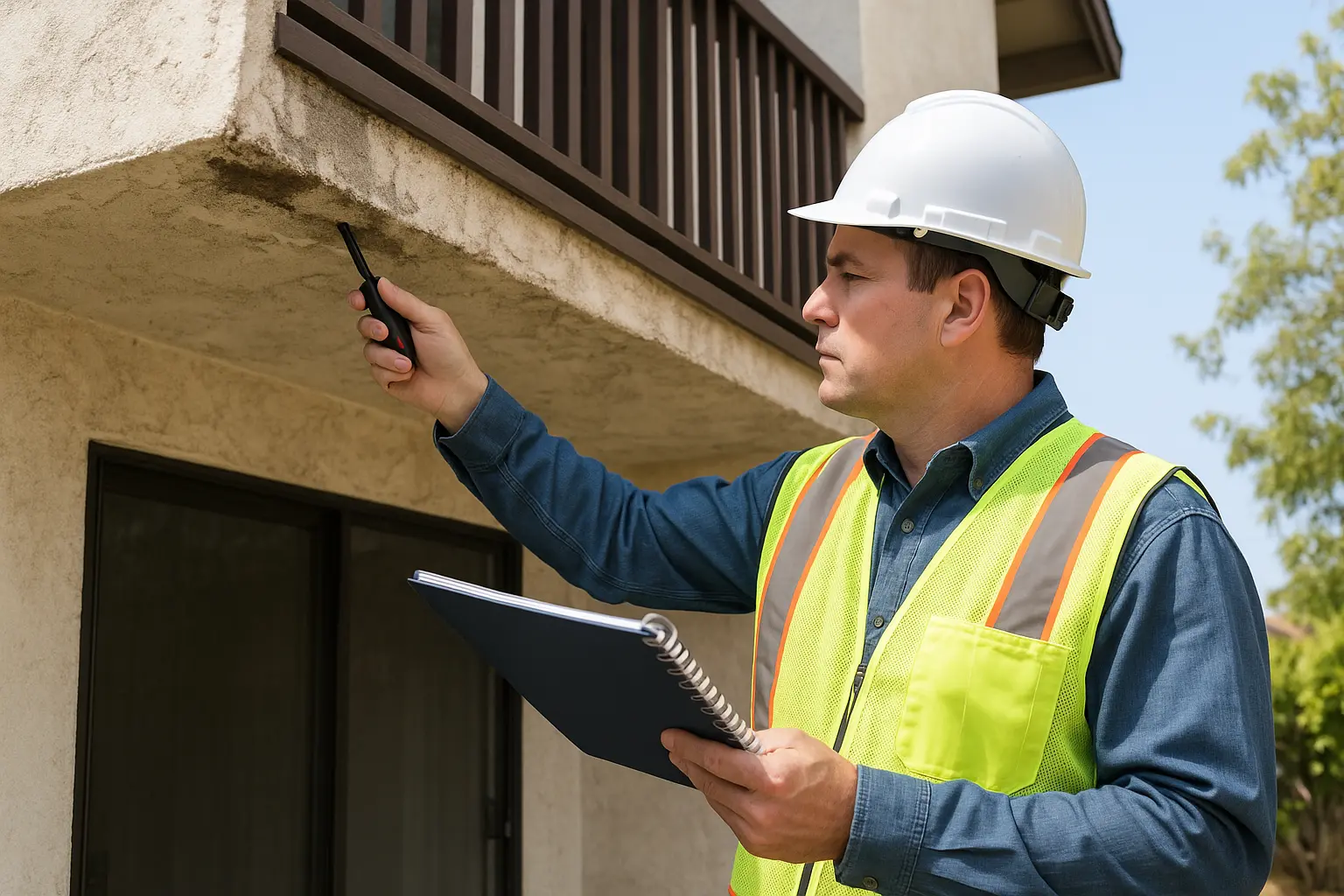California Balcony Laws Explained: SB-326, SB-721 & Section 604 Compliance Guide (2025)

By Omid Sedaghat, PE | Founder & CEO, DrBalcony | Updated: September 8, 2025
California has three major balcony safety frameworks—SB-326, SB-721, and San Francisco’s Section 604—all designed to prevent failures and protect residents. As of January 1, 2025, SB-326 first inspections were due for HOAs/condo associations (then every 9 years), and SB-721 (for apartments) now has an initial deadline of January 1, 2026 (then every 6 years). At DrBalcony, our engineers have completed 300+ inspections statewide, so this guide reflects field data, not just theory.
Table of Contents
- What Are SB 326, SB 721, and Section 604?
- Deadlines & Extensions (What changed and where)
- Key Features and Requirements of Each Regulation
- Insights From 300+ Real California Projects
- Practical Tips to Stay Ahead
- How DrBalcony Helps You Stay Compliant
- FAQ Section: Top Questions & Answers
What Are SB 326, SB 721, and Section 604?
Think of these laws as the guardians of exterior elevated elements (EEEs) like balconies, decks, and walkways. Enacted to prevent tragedies stemming from structural failures, these regulations focus on regular inspections and timely repairs. Here’s the enhanced breakdown:
- SB-326 (HOAs/Condos): Requires periodic inspections of exterior elevated elements (EEEs) in HOA-maintained areas; first inspection due by Jan 1, 2025, then every 9 years; findings must be incorporated into the reserve study; reports retained two cycles.
- SB-721 (Apartments): Applies to multifamily rentals; initial inspection by Jan 1, 2026; every 6 years; 15% sample of EEE types; penalties up to $500/day for non-compliance.
- Section 604 (SF only): Requires a licensed professional to inspect exterior attachments; affidavit filed every 5 years with SF DBI.
| Law | Applies To | First Inspection | Frequency | Who Can Inspect | Key Requirement | Penalties |
|---|---|---|---|---|---|---|
| SB-326 | HOAs / Condominiums (3+ units) | Jan 1, 2025 | Every 9 years | Licensed architect or engineer (civil engineers permitted via AB 2114) | Integrate report into reserve study; retain for two cycles | Local enforcement can recover costs; liens/fines possible |
| SB-721 | Multifamily rentals (3+ units) | Jan 1, 2026 (AB 2579) | Every 6 years | Architect/Engineer/Certified Inspector/Contractor (A/B/C-5, 5+ yrs) | Inspect a min. 15% of each EEE type; repair timelines apply | Up to $100–$500/day for non-compliance |
| SF Section 604 | San Francisco apartments, hotels; certain condos | Per SF DBI schedule | Every 5 years | General contractor, structural pest control, architect, or engineer | File Section 604 Compliance Affidavit with SF DBI | Local enforcement (notices, deadlines, possible liens) |
Contact DrBalcony for a professional inspection!
Ensure the safety of your balcony and living space with DrBalcony – We’re a Tech Engineering firm that specializes in California SB326 & SB721 balcony inspections. Over 300+ completed projects in California.
Deadlines & Extensions
- SB-326 (HOAs/Condos): First inspection by Jan 1, 2025, then every 9 years; findings integrate into the reserve study; retain reports for two cycles.
- SB-721 (Apartments): First inspection by Jan 1, 2026 (AB 2579 extension), then every 6 years; inspect a minimum 15% sample of each EEE type.
- SF Section 604:, file the Compliance Affidavit with SF DBI.
Key Features and Requirements of Each Regulation
SB 326: A Lifeline for HOA-Managed Properties
- Who It Impacts: HOAs managing properties with three or more units.
- Key Inspection Elements: detailed inspections of balconies, decks, and elevated walkways.
- Why It Matters: focuses on structural integrity and waterproofing to ensure EEEs are safe and well-maintained.
SB-326 requires HOA boards to hire a licensed architect or engineer to inspect a statistically significant sample of exterior elevated elements and document whether they are in a generally safe condition. The first inspection was due by January 1, 2025, with re-inspections every nine years, coordinated with the reserve study. Reports must be presented to the board, retained for two inspection cycles, and immediate hazards must be addressed with access restrictions and notifications to local enforcement where applicable.
SB 721: The Landlord’s Safety Net
- Who It Impacts: property owners managing multi-family residential buildings.
- Focus: addresses EEEs with an eye toward tenant safety.
- Compliance Requirements: submit thorough inspection reports and complete repairs within 120 days.
SB-721 applies to multifamily rental properties. Owners must complete the first inspection by January 1, 2026 and then every six years. A minimum of 15% of each exterior elevated element type must be inspected by a qualified professional. If hazardous conditions are found, local agencies can require immediate actions and impose daily penalties up to $500 for non-compliance.
Section 604: San Francisco’s Holistic Approach
- Who It Impacts: property owners in San Francisco.
- Focus: beyond EEEs, includes exterior components such as windows and siding.
- Unique Timeline: Every five years, property owners must ensure compliance with city-specific codes.
San Francisco’s Section 604 requires owners of covered buildings to have decks, balconies, stairs, and similar exterior attachments inspected every five years by a licensed professional and to file a signed Compliance Affidavit with the Department of Building Inspection.
What Our Inspections Show
From 300+ California inspections completed by DrBalcony engineers:
- 42% showed early-stage water intrusion or waterproofing failures, particularly around flashing and membrane interfaces
- 28% had structural concerns requiring immediate attention or monitoring, with wood-frame connections being the most vulnerable
- 65% required some level of remediation, but median repair costs were 73% lower when issues were caught during routine inspections vs. emergency failures
- 89% of properties built between 1990-2010 showed aging waterproofing systems approaching end-of-life
Top recurring issues identified:
- Flashing defects – Improperly installed or deteriorated step flashing at building interfaces
- Aging waterproofing membranes – Original systems reaching 15-25 year lifespan limits
- Deferred maintenance – Minor issues that compound into major structural concerns
- Drainage problems – Clogged or inadequate drainage systems leading to water retention
- Connection point deterioration – Bolts, brackets, and attachment hardware showing corrosion or loosening
Regional variations observed:
- Coastal areas: Higher rates of corrosion and salt damage to metal components
- Seismic zones: More connection-related issues and settlement-induced stress
- High-temperature regions: Accelerated membrane degradation and thermal expansion issues
Methodology: Data compiled from anonymized inspection reports of 312 properties across California (2023-2025), including both initial compliance inspections and follow-up assessments. Properties ranged from 3-unit condominiums to 200+ unit apartment complexes.
Practical Tips to Stay Ahead
- Know Your Deadlines: Familiarize yourself with the inspection timelines for each regulation.
- Hire Trusted Professionals: Always choose licensed architects or structural engineers who are well-versed in California’s codes.
- Document Everything: Keep detailed records of inspections, repairs, and compliance reports.
- Budget for Repairs: Allocate funds for potential fixes identified during inspections.
- Partner With Experts: Collaborate with a trusted provider like DrBalcony to ensure smooth, worry-free compliance.
How DrBalcony Helps You Stay Compliant
At DrBalcony, we understand the unique challenges of California’s balcony and deck inspection laws. Our team of experienced professionals simplifies the process, offering:
- Transparent Reporting: Detailed, actionable insights into the condition of your EEEs.
- Timely Inspections: We work with your schedule to ensure compliance without disruption.
- Expert Guidance: From initial inspections to final repairs, we’ve got you covered.
- Field-Proven Experience: Over 300 completed inspections across diverse California properties.
Contact DrBalcony for a professional inspection!
Ensure the safety of your balcony and living space with DrBalcony – We’re a Tech Engineering firm that specializes in California SB326 & SB721 balcony inspections. Over 300+ completed projects in California.
Final Thoughts
Compliance with California’s balcony inspection laws isn’t just about avoiding fines—it’s about ensuring safety and peace of mind for residents and property owners alike. By understanding the differences between SB-326, SB-721, and Section 604, you can confidently navigate inspections and protect your investments.
Take the first step toward compliance today! Contact DrBalcony for expert guidance and stress-free inspections.
FAQ Section: Top Questions & Answers
My property is well-maintained. Do I really need SB-326/SB-721 inspections?
YES! Even with excellent maintenance, hidden issues can develop due to construction errors, material flaws, or severe weather exposure. Inspections are about ensuring those don’t turn into major problems.
Our balconies were inspected a few years ago—isn’t that enough?
Unfortunately, no. California laws mandate inspections on a set schedule, often every 6 to 9 years. Deterioration can happen quickly, making regular assessments essential.
Can I use my regular handyman for the balcony inspection?
It’s not recommended. Unless they hold specific licenses (architect, structural engineer, etc.) their inspection won’t be considered valid for SB-326/SB-721 compliance.
Who pays—HOA or individual owners?
HOA-maintained EEEs are typically the association’s responsibility; check CC&Rs and Civil Code §5551 for maintenance obligations.
What happens if immediate hazards are found?
Restrict access immediately. The inspector’s report can trigger notification to local enforcement within 15 days and prioritized remediation.
What qualifies an SB-721 inspector?
Architect, engineer, certified building inspector/official, or contractor (A/B/C-5) with five years’ experience in multistory wood-frame.
Does San Francisco require proof of inspection?
Yes—Section 604 Compliance Affidavit filed with SF DBI every 5 years.
What if the inspection uncovers major issues?
First, don’t panic! Early detection often means less extensive (and expensive) repairs are needed. Work with your inspector to prioritize fixes, and explore if they offer repair services for a streamlined solution.
I’m worried about the cost of inspections. Are there any resources to help?
Start by getting detailed quotes from multiple companies. Factor in that proactive inspections help you avoid even bigger costs down the line due to neglected problems. Some property management associations offer guidance on budgeting for balcony compliance.
